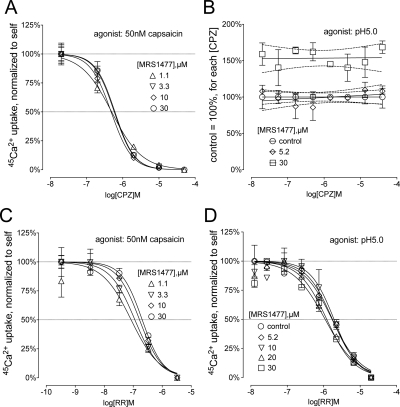Fig. 5.
MRS1477 does not affect TRPV1 inhibition by capsazepine or ruthenium red. A, increasing concentrations of MRS1477 potentiate activation of TRPV1 by 50 nM capsaicin up to 3-fold (Supplemental Fig. 3A). The CPZ interaction with TRPV1 remains unaffected, as the normalized dose-inhibition curves show no change in CPZ IC50 values. B, CPZ is a partial inhibitor of TRPV1 activation by protons, yielding incomplete dose-inhibition curves that show a linear increase in inhibition with increasing doses of CPZ (Supplemental Fig. 3B). Normalizing calcium uptake to each CPZ concentration without MRS1477 produces a horizontal line at 100% for control. Potentiation is apparent at all CPZ concentrations, ∼50% above control in the presence of 30 μM MRS1477 (dashed lines represent upper and lower 95% CI). C, RR inhibition of capsaicin-activated TRPV1 in the presence of increasing amounts of MRS1477 shows a progressive potentiation of the TRPV1 response (Supplemental Fig. 3C). Normalized curves show a small but nonsignificant reduction in RR IC50 values with high concentrations of MRS1477. D, RR is also an inhibitor of proton activation of TRPV1. It does not interfere with potentiation by MRS1477 (Supplemental Fig. 3D), whereas normalized dose-inhibition curves of RR show no change in RR potency in the presence of MRS1477.

